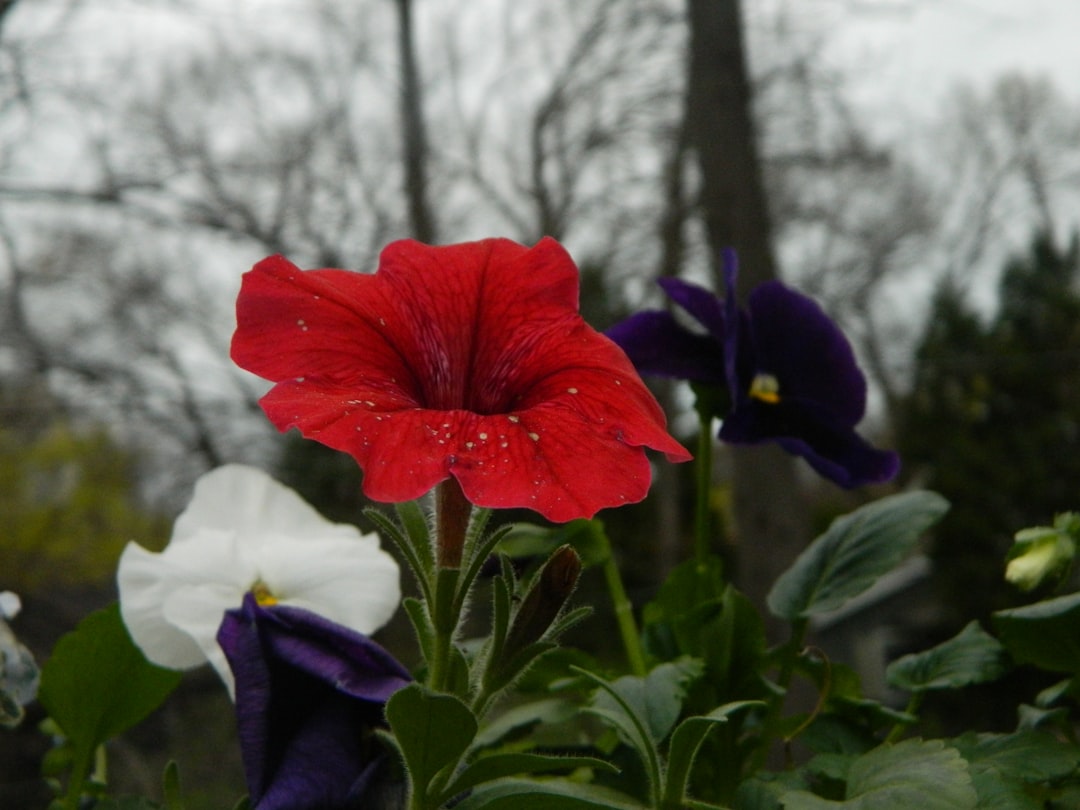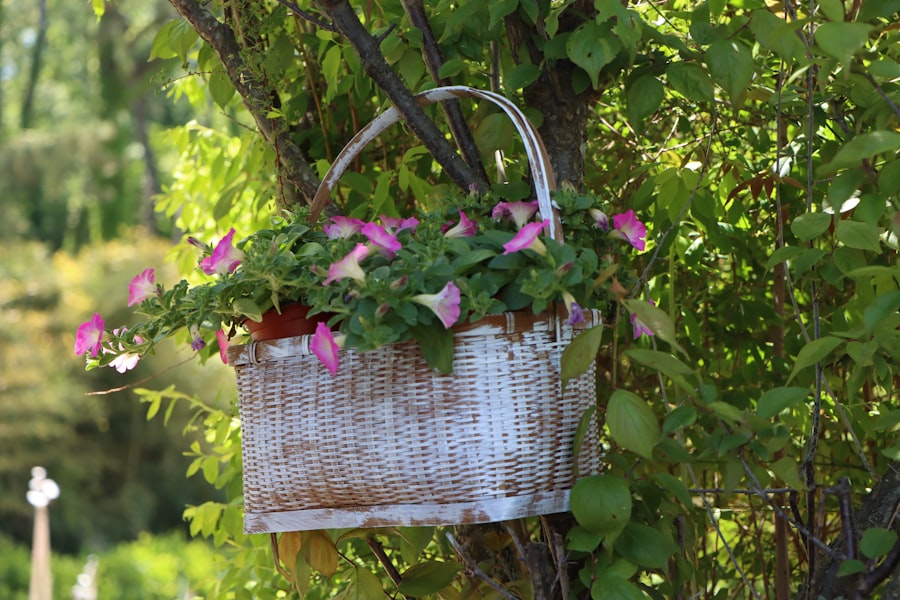Petunia Plant Care: Tips for a Healthy Bloom

Petunias are beautiful flowering plants that are widely popular in gardening and landscaping. They belong to the Solanaceae family and are native to South America, particularly Argentina and Brazil. The name “petunia” is derived from the French word “petun,” which means tobacco, as the plant is closely related to tobacco plants.
Petunias were first discovered by European explorers in the 18th century and were brought back to Europe. They quickly gained popularity due to their vibrant colors and ability to bloom throughout the summer months. Today, petunias are one of the most commonly grown annual flowers in gardens around the world.
Petunias are highly valued for their versatility in garden design. They can be used as bedding plants, in containers, hanging baskets, or as ground cover. Their wide range of colors, including shades of pink, purple, red, white, and yellow, make them a popular choice for adding a splash of color to any garden or landscape.
Key Takeaways
- Petunias are popular annual plants that come in a variety of colors and sizes.
- There are four main types of petunias: grandiflora, multiflora, milliflora, and spreading.
- Petunias prefer well-draining soil with a pH between 6.0 and 7.5.
- Water petunias deeply once a week, or more frequently in hot weather.
- Fertilize petunias every two to three weeks with a balanced fertilizer.
Understanding the Different Types of Petunias
Petunias come in a variety of types based on their growth habit, flower size, and color. Understanding these different types can help gardeners choose the right petunias for their specific needs.
1. Grandiflora Petunias: These petunias have large flowers that can reach up to 4 inches in diameter. They come in a wide range of colors and are known for their showy blooms. Grandiflora petunias are best suited for containers or as focal points in flower beds.
2. Multiflora Petunias: Multiflora petunias have smaller flowers than grandiflora varieties but produce more blooms. They are more compact and bushy in growth habit, making them ideal for mass plantings or hanging baskets.
3. Wave Petunias: Wave petunias are known for their spreading growth habit and ability to trail or cascade over the edges of containers or hanging baskets. They produce an abundance of small to medium-sized flowers and are available in a wide range of colors.
4. Surfinia Petunias: Surfinia petunias are a type of trailing petunia that is known for its vigorous growth and ability to cover large areas. They are often used in hanging baskets or as ground cover.
5. Calibrachoa Petunias: Calibrachoa, also known as million bells, are closely related to petunias and have similar trumpet-shaped flowers. They come in a wide range of colors and are known for their prolific blooming throughout the summer months.
Choosing the Right Soil for Petunias
Choosing the right soil is crucial for the successful growth of petunias. They prefer well-draining soil that is rich in organic matter.
1. Ideal Soil pH and Texture: Petunias prefer slightly acidic soil with a pH range of 5.5 to 6.5. The soil should also be loamy or sandy, allowing for good drainage. Heavy clay soils should be amended with organic matter to improve drainage.
2. Soil Amendments and Fertilizers: Adding organic matter, such as compost or well-rotted manure, can improve the soil structure and fertility. This will help retain moisture while allowing excess water to drain away. Additionally, incorporating a slow-release fertilizer into the soil before planting can provide essential nutrients for healthy growth.
Watering Petunias: How Much is Enough?
| Watering Frequency | Soil Moisture Level | Petunia Growth |
|---|---|---|
| Once a week | Dry | Poor |
| Twice a week | Slightly moist | Good |
| Three times a week | Moist | Excellent |
| Four times a week | Wet | Poor |
Proper watering is essential for the health and vitality of petunias. Overwatering or underwatering can lead to various problems, including root rot or wilting.
1. Watering Frequency and Amount: Petunias should be watered deeply but infrequently. It is best to water them when the top inch of soil feels dry to the touch. Watering in the morning or evening is ideal to minimize evaporation and allow the plants to dry before nightfall.
2. Signs of Overwatering and Underwatering: Overwatered petunias may develop yellowing leaves, wilting, or root rot. On the other hand, underwatered petunias may have drooping leaves, dry soil, or a wilted appearance. It is important to strike a balance and avoid extremes in watering.
Fertilizing Petunias: When and How to Do It
Fertilizing petunias is essential for promoting healthy growth and abundant blooming throughout the growing season.
1. Importance of Fertilizing: Petunias are heavy feeders and require regular fertilization to thrive. Fertilizers provide essential nutrients, such as nitrogen, phosphorus, and potassium, which are necessary for plant growth and flowering.
2. Types of Fertilizers: There are various types of fertilizers available for petunias, including granular slow-release fertilizers, water-soluble fertilizers, and organic fertilizers. Slow-release fertilizers are convenient as they provide a steady supply of nutrients over an extended period. Water-soluble fertilizers can be applied every two weeks during the growing season for a quick nutrient boost. Organic fertilizers, such as compost or well-rotted manure, can also be used to provide nutrients naturally.
3. Application Methods: Fertilizers can be applied by broadcasting them around the base of the plants or by incorporating them into the soil before planting. It is important to follow the instructions on the fertilizer packaging for proper application rates.
Pruning Petunias: Keeping Them in Shape

Pruning petunias is an important maintenance practice that helps promote bushiness and flowering.
1. Benefits of Pruning: Pruning helps remove dead or faded flowers, which encourages the plant to produce more blooms. It also helps maintain a compact and tidy appearance. Pruning can also help prevent the plant from becoming leggy or overgrown.
2. Techniques for Pruning: To prune petunias, simply pinch or snip off the faded flowers just above a set of healthy leaves or buds. This will encourage new growth and more flowers to form. It is important to use clean and sharp pruning shears to avoid damaging the plant.
Dealing with Common Petunia Pests and Diseases
Petunias are susceptible to various pests and diseases that can affect their health and blooming.
1. Common Pests: Some common pests that affect petunias include aphids, spider mites, whiteflies, and slugs. These pests can cause damage to the leaves, flowers, or stems of the plants.
2. Prevention and Treatment: To prevent pest infestations, it is important to maintain good garden hygiene by removing weeds and debris that can harbor pests. Regularly inspecting the plants for signs of pests and taking prompt action, such as using insecticidal soaps or organic pest control methods, can help prevent further damage.
3. Common Diseases: Petunias are susceptible to diseases such as powdery mildew, botrytis blight, and root rot. These diseases can cause leaf spots, wilting, or stunted growth.
4. Prevention and Treatment: Proper cultural practices, such as providing adequate air circulation and avoiding overwatering, can help prevent disease outbreaks. Fungicides or other disease control measures may be necessary if diseases become severe.
Sunlight Requirements for Petunias
Petunias require a certain amount of sunlight to thrive and produce abundant blooms.
1. Ideal Sunlight Exposure: Petunias prefer full sun exposure, which means they should receive at least 6 to 8 hours of direct sunlight per day. Insufficient sunlight can result in weak growth and reduced blooming.
2. Effects of Too Much Sunlight: While petunias love sun, excessive heat and intense sunlight can cause the plants to wilt or scorch. Providing some shade during the hottest part of the day can help protect them from extreme heat.
3. Effects of Too Little Sunlight: Insufficient sunlight can result in leggy growth and reduced blooming. If petunias are grown in areas with limited sunlight, they may benefit from supplemental lighting or choosing shade-tolerant varieties.
Transplanting Petunias: How and When to Do It
Transplanting petunias is necessary when they outgrow their containers or need to be moved to a different location.
1. Reasons for Transplanting: Petunias may need to be transplanted if they become root-bound in their containers or if they need to be relocated to a different area of the garden. Transplanting can also help rejuvenate older plants that have become leggy or overgrown.
2. Steps for Transplanting: To transplant petunias, gently remove them from their current container or location, being careful not to damage the roots. Dig a hole in the new planting area that is slightly larger than the root ball of the plant. Place the plant in the hole, backfill with soil, and water thoroughly.
Overwintering Petunias: Tips for Success
Petunias are typically grown as annuals, but with proper care, they can be overwintered and enjoyed for another season.
1. How to Prepare Petunias for Winter: Before the first frost, it is important to prepare petunias for winter by cutting them back to a few inches above the soil level. Remove any dead or diseased foliage and clean up the garden area to prevent the spread of pests and diseases.
2. Methods for Overwintering: Petunias can be overwintered indoors or outdoors, depending on the climate. In colder regions, it is best to bring potted petunias indoors and place them in a cool, well-lit area. In milder climates, petunias can be left in the ground with a layer of mulch to protect them from frost.
In conclusion, petunias are versatile and beautiful flowering plants that can add a splash of color to any garden or landscape. Understanding their different types, soil requirements, watering and fertilizing needs, pruning techniques, and how to deal with common pests and diseases is essential for their successful growth. By providing the right conditions and care, petunias can thrive and provide months of vibrant blooms.
If you’re looking for expert advice on how to care for your petunia plants, look no further than Lawn World’s comprehensive guide. Their article on petunia plant care is a must-read for any petunia enthusiast. From choosing the right soil and watering techniques to pruning and fertilizing tips, this article covers it all. Discover the secrets to keeping your petunias healthy and vibrant by clicking here.
FAQs
What are petunia plants?
Petunia plants are flowering plants that are commonly grown in gardens and containers. They come in a variety of colors and sizes and are known for their trumpet-shaped blooms.
What is the best way to care for petunia plants?
Petunia plants require regular watering, fertilization, and deadheading to thrive. They also need to be planted in well-draining soil and placed in an area that receives at least six hours of sunlight per day.
How often should I water my petunia plants?
Petunia plants should be watered regularly, but not overwatered. The soil should be kept moist, but not waterlogged. It is best to water petunia plants in the morning or evening to avoid evaporation.
What type of fertilizer should I use for my petunia plants?
Petunia plants benefit from a balanced fertilizer that contains equal amounts of nitrogen, phosphorus, and potassium. It is best to fertilize petunia plants every two to three weeks during the growing season.
What is deadheading and why is it important for petunia plants?
Deadheading is the process of removing spent blooms from a plant. It is important for petunia plants because it encourages the plant to produce more blooms and prevents the plant from going to seed too quickly.
What are some common pests and diseases that affect petunia plants?
Common pests that affect petunia plants include aphids, spider mites, and whiteflies. Common diseases include powdery mildew and botrytis blight. It is important to monitor petunia plants regularly for signs of pests and diseases and to take appropriate action if necessary.



